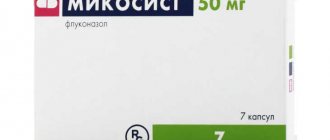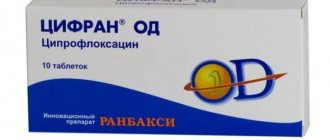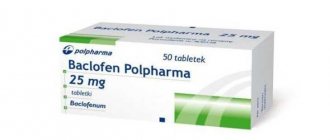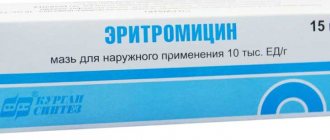Photo: yandex.ru
Photo: yandex.ru Photo: yandex.ru Photo: zdravcity.ru
Azitral is an antibiotic from the macrolide group. Active ingredient: Azithromycin.
Azitral has a bacteriostatic effect. The drug has the highest concentration in tissues than in the blood, because the antibiotic binds little to plasma proteins, and because of this, the half-life is high (up to 41 hours). The drug is prescribed by a doctor!
Pharmacological properties of the drug Azitral
Azithromycin is an antibiotic of the macrolide group (a subgroup of azalides) with a broad spectrum of action. Has a bactericidal effect. Penetrates into tissues, cells and body fluids; Compared to other macrolides, azithromycin has the longest half-life. To achieve a clinical effect, in most cases, a 3-5-day course of therapy is sufficient. Pharmacodynamics. Azithromycin binds to the 50S ribosomal subunit of microorganisms and suppresses RNA-dependent protein biosynthesis. Slows down the growth and reproduction of bacteria; in high concentrations it exhibits a bactericidal effect. Active against gram-positive aerobic microorganisms: Staphylococcus aureus, Staphylococcus epidennidis, Streptococcus pneumoniae, Streptococcus agalactiae, Streptococcus pyogenes, Streptococcus viridans, streptococci of groups C, F and G. Gram-positive microorganisms resistant to erythromycin show cross-resistance to azithromycin. Most strains of Enterococcus faecalis and methicillin-resistant staphylococci are resistant to azithromycin. Of the gram-negative aerobic microorganisms that are sensitive to azithromycin: Bordetella pertussis, Bordetella parapertussis, Brucella melitensis, Campylobacter jejuni, Escherichia coli, Gardnerella vaginalis, Haemophilus influenzae, Haemophilus parainfluenzae, Haemophilus ducreyi, Helicobacter pylori, Legionella pneumophila, Moraxella catarrhal is, Neisseria gonorrhoeae, Neisseria meningitidis, Shigella spp., Salmonella spp., Yersinia spp. Of the anaerobes that are sensitive to azithromycin: Bacteroides bivius, Clostridium perfringens spp., Peptococcus spp., Pi'ptostreptococcus spp. The following are also sensitive to azithromycin: Borrelia burgdorferi, Chlamydia trachomatis, Chlamydia pneumoniae. Listeria monocitogenes, Mycobacteria avium complex, Mycoplasma pneumoniae, Treponema pallidum. Ureaplusma urealyticum. Pharmacokinetics. Azithromycin quickly penetrates from the blood plasma and is distributed in the tissues of the body in high concentrations (in the tissues of the respiratory tract, organs and tissues of the urogenital tract (in particular the prostate), in the skin and soft tissues). The high concentration in tissues (10–50 times higher than in blood plasma) and long half-life are due to the low binding of azithromycin to plasma proteins, as well as its ability to penetrate eukaryotic cells and concentrate in the low pH environment surrounding lysosomes. This in turn determines the large volume of distribution (31.1 l/kg body weight) and high plasmatic clearance (630 ml/min), which allow azithromycin to accumulate in tissues followed by slow release. The ability of azithromycin to accumulate predominantly in lysosomes is especially important for the elimination of intracellular pathogens. High antimicrobial activity is also due to the ability of azithromycin to accumulate in leukocytes (granulocytes and monocytes/macrophages), by which the antibiotic is transported to foci of inflammation and released during phagocytosis. Despite its high concentration in phagocytes, azithromycin does not significantly affect their function. The concentration of the drug in the inflammation site is 24–34% higher than in healthy tissues and correlates with the degree of inflammatory edema. 12–72 hours after administration, azithromycin accumulates in a high therapeutic concentration (1–9 mg/kg) at the site of inflammation. When taken orally, azithromycin is rapidly absorbed from the gastrointestinal tract due to its stability in an acidic environment and lipophilicity. After taking the drug at a dose of 500 mg, Cmax in blood plasma is reached after 2–3 hours and is 0.4 mg/l. Concomitant food intake slows down pharmacokinetic parameters. The pharmacokinetics of azithromycin in healthy volunteers after a single intravenous infusion lasting 2 hours at a dose of 1000-4000 mg (solution concentration - 1 mg/ml) is characterized by a linear dependence. Bioavailability after a single dose is 37%, subsequently it is inversely proportional to the concentration in the blood plasma and amounts to 7–50%. In healthy volunteers, after an intravenous infusion of azithromycin at a dose of 500 mg (solution concentration - 1 mg/ml), the Cmax of the drug in the blood plasma was 1.14 ppm/ml for 3 hours. A stable level of concentration in the blood plasma is achieved after 5–7 days. Cmin (0.18 μg/ml) is observed during the first 24 hours and AUC is 8.03 μg/ml/h. Similar pharmacokinetic parameters were also obtained when using azithromycin for 2–5 days in patients with community-acquired pneumonia. After using azithromycin at a dose of 500 mg for 5 days, 14% of the drug is eliminated during the 24-hour interval between doses. Elimination of azithromycin from blood plasma occurs in 2 stages: half-life in the first phase (within 8–24 hours after taking the drug) is 14–20 hours; in the second phase - 41 hours (24–72 hours after administration). Due to the long half-life, Azitral is slowly eliminated from the body (on average 60–76 hours), which makes it possible to prescribe it once a day and significantly reduce the duration of treatment to 3–5 days; at the same time, the high concentration of the active substance in the tissues remains for 5–7 days after discontinuation of the drug. Metabolized mainly in the liver by demethylation, the metabolites are inactive. The drug is eliminated mainly with bile (50%) unchanged, a small part (6%) is excreted by the kidneys. Features of pharmacokinetics in different age groups: in elderly men (65–85 years) the pharmacokinetic parameters do not change, in women Cmax increases (by 30–50%), in children aged 1–5 years Cmax, Tmax, and AUC decrease.
Indications for use of the drug Azitral
Infections caused by microorganisms sensitive to azithromycin:
- lower respiratory tract (acute bronchitis, chronic bronchitis in the acute stage, community-acquired bacterial pneumonia, atypical pneumonia;
- ENT organs (tonsillitis, tonsillitis, pharyngitis, tracheitis, sinusitis, otitis externa, purulent otitis media of unspecified etiology);
- skin and soft tissues (Lyme disease, folliculitis, furunculosis, carbuncle, secondary pyoderma and pyodermatoses, impetigo, infectious dermatitis and myositis, erysipelas);
- urethritis, prostatitis, cervicovaginitis, salpingitis (including those caused by chlamydia and mycoplasmas);
- diseases of the stomach and duodenum associated with Helicobacter pylori (as part of combination therapy);
- intestinal infections (shigellosis, salmonellosis, campylobacteriosis, cryptosporidiosis);
- diphtheria, scarlet fever;
- dental infections;
- infections of any localization caused by atypical pathogens: mycoplasmas
- chlamydia
- ureaplasmas.
Use of the drug Azitral
Pills. Azithromycin is taken orally 1 time per day, at least 1 hour before or 2 hours after meals. For adults: for infections of the respiratory tract, skin and soft tissues: 500 mg once a day for 3 days (1.5 g per course of treatment). For chronic migratory erythema: 1 g on day 1, then 500 mg from days 2 to 5 (course dose - 3.0 g). For diseases of the stomach and duodenum associated with Helicobacter pylori , as part of complex therapy - 1 g/day for 3 days. For sexually transmitted diseases, 1 g is prescribed once; for complicated, long-term forms of infections caused by associations with Chlamydia trachomatis - 1 g 3 times with an interval of 7 days (1-7-14, course dose - 3 g). For children: for infections of the respiratory tract, skin and soft tissues - 10 mg/kg body weight once a day for 3 days (course dose - 30 mg/kg); for chronic migratory erythema - 20 mg/kg body weight once a day for 5 days on the 1st day, then 10 mg/kg body weight from the 2nd to the 5th day. For infections caused by typical flora, it is recommended to use the following regimen of azithromycin.
Age | Dosage regimen |
| 6 months–8 years | 10 mg/kg 1 time per day for 3 days |
| 8–12 years | 1 tablet (250 mg) 1 time per day for 3 days |
| Adults | 1 tablet (500 mg) 1 time per day for 3 days |
If you miss taking the drug, the missed dose should be taken as soon as possible, and subsequent doses at the usual interval of 24 hours. Powder for preparing a solution for intravenous infusion. Azitral cannot be administered intravenously or intramuscularly! A slow intravenous infusion of the prepared solution is recommended (500 ml of the solution must be administered over at least 30 minutes). For the treatment of community-acquired pneumonia in adults and children over 16 years of age - 500 mg 1 time per day intravenously infusion for 2–3 days. After completing the course of infusions, it is recommended to use azithromycin orally once a day, 500 mg, until the end of the 10-day general course of therapy. For the treatment of infectious and inflammatory diseases of the pelvis - 500 mg once a day intravenously for 2-3 days. After completing the course of infusions, it is recommended to prescribe azithromycin orally once a day, 250 mg, until the end of the 7-day general course of treatment. The timing of the transition from IV administration of Azitral to oral administration is determined by the doctor in accordance with the clinical examination data. The solution for infusion is prepared in 2 steps: 1 - preparation of the primary solution: add 4.8 ml of water for injection to a bottle containing 500 mg of the drug and shake thoroughly until the powder is completely dissolved; 1 ml of the resulting solution contains 100 mg of azithromycin, this solution can be stored for 24 hours at a temperature not exceeding 25 °C; 2 - secondary dilution: the primary solution is added to a bottle with a solvent (0.9% sodium chloride solution, 5% dextrose solution, Ringer's solution) until the final concentration of azithromycin is obtained in the infusion solution - 1– 2 mg/ml, as given in the table:
Azithromycin concentration, mg/ml | Solvent volume, ml |
| 1 | 500 |
| 2 | 250 |
The resulting solution remains stable for 24 hours provided it is stored at room temperature (not higher than 25 °C) and for 7 days in the refrigerator (5 °C).
Analogues of Azitral
- Azithromycin
- Azibiote
- Azivok
- Azidrop
- Azimicin
- Azitrox
- AzitRus (cheaper analogue of Azitral)
- Zetamax Retard
- Z-Factor
- Ziromin
- Zitnob
- Zitrolide
- Sumaclid
- Sumamed
- Sumamox
- Tremak-Sanovel
- Hemomycin
Side effects of the drug Azitral
Azithromycin very rarely causes side effects. Possible gastrointestinal disorders (anorexia, flatulence, nausea, vomiting, diarrhea, pain in the epigastric region); in case of hypersensitivity to the components of the drug - allergic reactions (skin rash, urticaria, photosensitivity, Quincke's edema); from the cardiovascular system - palpitations, pain in the chest; from the central nervous system - dizziness, headache, lethargy, hyperkinesia, neurosis, sleep disturbance. A reversible moderate increase in the activity of liver enzymes, neutropenia, and, extremely rarely, neutrophilia and eosinophilia may also be observed. These indicators normalize 2–3 weeks after completion of treatment. An inflammatory reaction may occur at the injection site.
Special instructions for the use of the drug Azitral
Prescribe with caution in severe liver dysfunction. In elderly people there is no need to adjust the dose. During pregnancy and breastfeeding. Experimental studies have not revealed teratogenic or embryotoxic effects. But given the insufficiency of these data, it is not recommended to prescribe azithromycin during pregnancy and lactation, unless the expected effect exceeds the possible risk of using the drug for the fetus. Breastfeeding should be discontinued during drug therapy. When treating sexually transmitted infections, both partners must be treated. The drug should not be used in longer courses than recommended, since its pharmacokinetics allow short courses of treatment to be recommended.
Contraindications
Antibiotic use is limited when:
- renal or liver failure;
- lactation and pregnancy;
- under 12 years of age;
- allergies to substances included in its composition.
Drug interactions Azitral
Antacids containing aluminum, magnesium, ethanol reduce the absorption of azithromycin, so the drug must be taken 1 hour before or 2 hours after taking antacids. Does not bind to enzymes of the cytochrome P450 complex and therefore does not interact with theophylline, terfenadine, carbamazepine, triazolam, digoxin, warfarin, phenytoin, ergotamine and cyclosporine. If simultaneous use with warfarin is necessary, it is recommended to regularly monitor prothrombin time. When used in combination with ergotamine and dihydroergotamine, their toxic effect (vasospasm, dysesthesia) may increase. Lincosamine weakens, and tetracycline and chloramphenicol enhance the effectiveness of azithromycin. Pharmaceutically incompatible with heparin.
Release form and composition
The drug format is gelatin capsules of 250 or 500 mg of azithromycin dihydrate.
The drug format is gelatin capsules of 250 or 500 mg of azithromycin dihydrate.
The contents of the capsules are white powder. The following additional substances were used:
- sodium lauryl sulfate;
- anhydrous lactose;
- magnesium stearate;
- corn starch;
- purified water;
- gelatin;
- methylparaben;
- propylparaben;
- titanium dioxide.
Capsules are sealed in strips of 3 or 6 pieces. The package contains 1 strip.
Azitral capsules are sealed in strips of 3 or 6 pieces. The package contains 1 strip.










